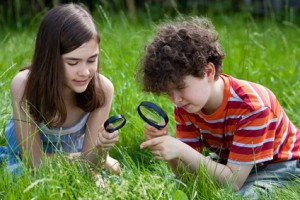Don’t Squelch Your Little Creative Genius
Children are born creative geniuses. At least that’s what a study by George Landis of NASA discovered (Learn more about that study in this TedTalk). He had developed a test for NASA to determine the creativity of job applicants. As they gave it to job applicants, questions arose—like, “Where does creativity come from?” and “Are we born creative, or do we learn creativity?” In an attempt to get some answers to these questions, they utilized this test of creativity to discover the level of creativity in children.
- They tested 1,600 children (4- to 5-years of age) and found that 98% fell into the category of creative genius.
- They then tested the same children 5 years later (at about 10-years of age). The percentage who tested in the genius category of imagination fell to 30%.
- Again, the children were tested at 15-years of age. The percentage fell to 12%.
- They also gave the test to about 2,800 adults and found the percentage of adults falling into the category of genius was only 2%.
How discouraging is that? The creativity of a person seemed to decrease over time. The authors of this study believe this decline occurred because we teach our children to judge and criticize ideas before dreaming or generating new ideas, even instead of dreaming or generating new ideas. We teach them to seek the “one right answer,” even for new problems that arise. In doing so, we silence the creative idea generating parts of our brain.
We face many “new” problems in our world today, problems ranging from technology to social relationships to environmental needs. In other words, creativity could prove a valuable asset in our world. Fortunately, we are all born with a streak of creative genius. For the sake of our world and our happiness, we need our children to flourish as creative geniuses as they mature. We need them to maintain their creative flare so they can meet the challenges of this world with various solutions…and we need our own 5-year-old creative genius to reemerge and help us to start our families on a new and creative path of solutions to the challenges we face today. How can we do this?
- Create opportunities for creative expression. Allow your children the opportunity to engage in creative activities and creative problem-solving.
- Stop and listen to creative moments that naturally arise. When your child offers a suggestion or a possible solution to some problem, stop and listen. Even if it sounds outlandish at first, stop and consider the possibility. Rather than judge or criticize, talk about their thoughts and ideas. Talk through the possibilities with them. When your child creates an art project, observe it and recognize a particular aspect you like or find interesting rather than judge and criticize. Who cares if the sky is green or the fish have wings? Allow creative expression and exploration. You will be pleasantly surprised by your child’s creative reasoning.
- Encourage a growth mindset rather than a fixed mindset. You can do this by acknowledging effort more than outcome. Recognize specific details about their work rather than offering global praises and acknowledgments. Avoid labeling your child as “creative” or “not creative.” Rather than label, simply acknowledge their effort and the interesting details of their project.
- Also, frame “failures” and “setbacks” as opportunities to learn. This also contributes to a growth mindset. Besides, when you think about it, creativity is all about learning from what doesn’t work and applying what you learn in a new way to discover a new solution. Allow your children the joy of failures and setbacks along with the opportunities to learn from them.
- Play. Have fun and play. You might even make up the game if you don’t have one in mind already. You can also enjoy playing with words by telling jokes or stories. Play with music by singing or playing an instrument. Even make an instrument. Play catch. Play a sport. Play slow motion tag. Play anything you like…just play and have fun.
- Encourage curiosity. Travel. Try a new food. Go to an art museum. Play a new game. Enjoy new and novel activities. All of this will encourage curiosity.
Creativity adds joy to life. Creativity supports resilience and perseverance. Creativity opens the door to creating a better world for our children and grandchildren. Nurture your creativity and your children’s creativity…it will make the world a better place.

-0 Comment-